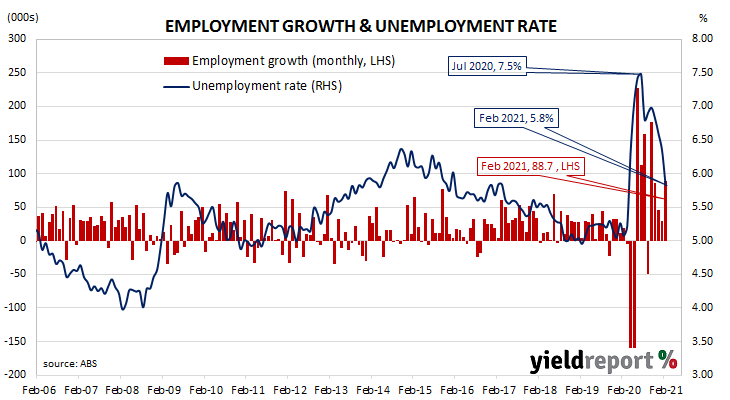Summary: Employment grows in February; employment number increase significantly larger than expected figure; aggregate job losses from 2020 now recovered; data “remarkable”, requires confirmation; participation rate unchanged; fewer people seeking work, larger available workforce sends jobless rate below 6%; fewer part-time jobs, more full-time jobs; work hours rise markedly; underemployment rate up; “total labour market slack still elevated”.
Australia’s period of falling unemployment came to an end in early 2019 when the jobless rate hit a low of 4.9%. It then averaged around 5.2% through to March 2020, bouncing around in a range from 5.1% to 5.3%. Leading indicators such as ANZ’s Job Ads survey and NAB’s capacity utilisation estimate suggested the unemployment rate would rise in the June 2020 quarter and it did so, sharply. The jobless rate peaked in July before falling below 7% in August. Since then, it has continued to trend lower.
The latest Labour force figures have now been released and they indicate the number of people employed in Australia according to ABS definitions increased by 88,700 in February. The rise was more than January’s 29,500 increase and significantly larger than the generally expected figure of 30,000.
“Nationally, before COVID hit, the level of employment peaked in February 2020 at 13.0 million, meaning after today’s gains, employment has recovered the aggregate job losses,” said UBS economist George Tharenou.

Domestic Treasury bond yields moved higher across the curve, outpacing overnight movements of their US Treasury bond counterparts. By the end of the day, the 3-year ACGB yield had gained 3bps to 0.29%, the 10-year yield had increased by 6bps to 1.82% while the 20-year yield finished 8bps higher at 2.52%.
In the cash futures market, expectations of a change in the actual cash rate, currently at 0.03%, remained largely stable, although 2022 contracts crept up a little. At the end of the day, contract prices implied the cash rate would inch up slowly to around 0.10% by mid-2022.
“The labour market data is remarkable, and materially stronger than expected by such a large margin that we cautiously wait for another print to confirm the scale of improvement, given the potentially large statistical errors in such a small sample in the LFS,” said Tharenou.
The participation rate remained unchanged from January’s 66.1% as the total available workforce increased by 18,800 to 13,812,100. The number of unemployed persons dropped by 69,900 to 805,200; the lower unemployment number in conjunction with the increase in the number of people in the workforce led to a fall in the unemployment rate from 6.3% to 5.8%.

